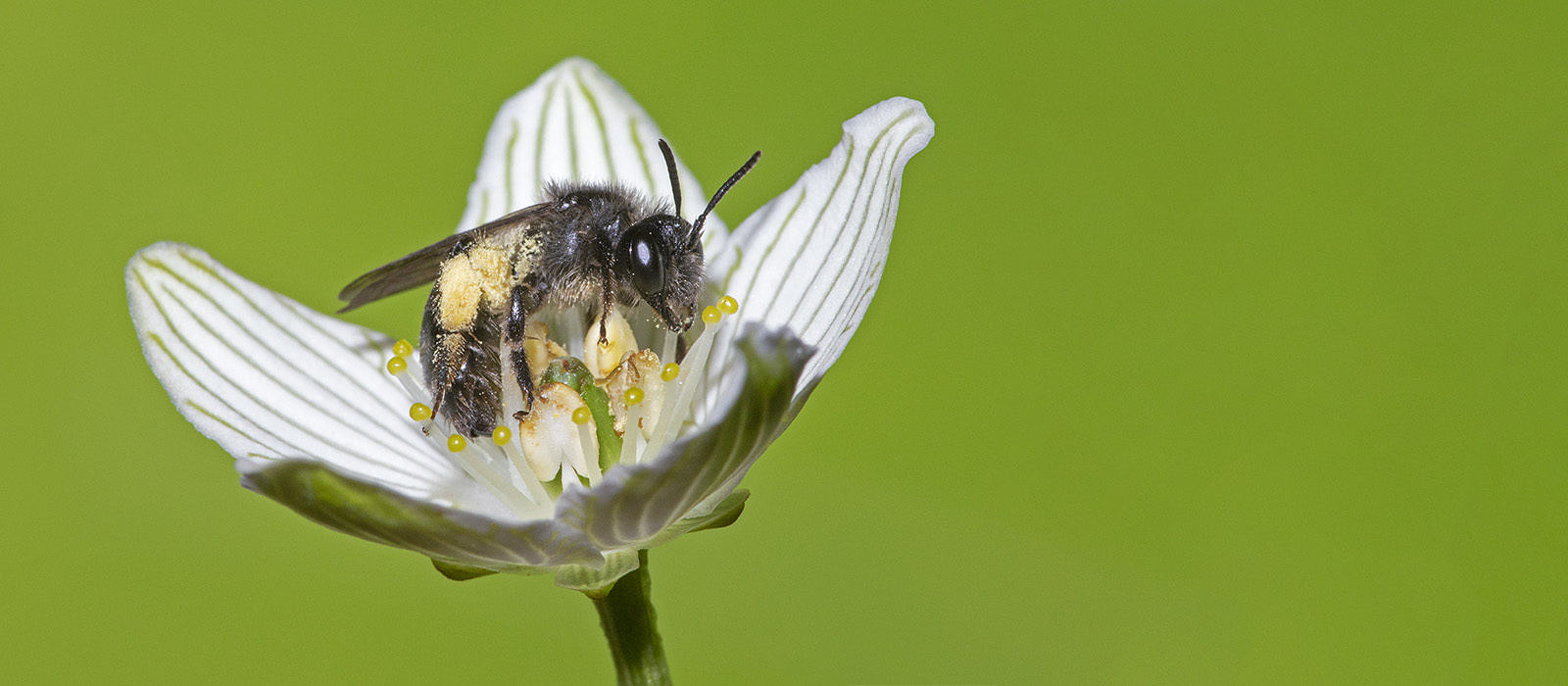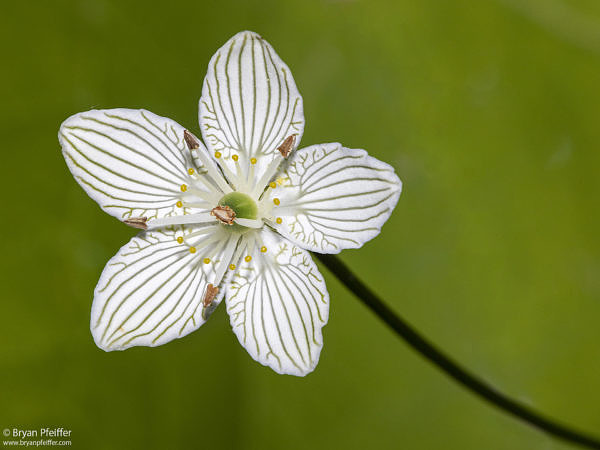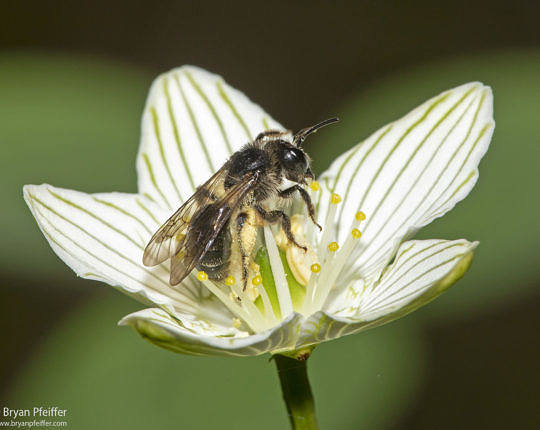
A Rare Bee and an Audacious Beetle
Atop a Handsome Flower and Through a Frog's Butt
If you ever doubted the fortitude of insects, I now bring you a beetle that, when swallowed by a frog, proceeds to crawl out of its butt unscathed. I also bring you my images of a rare bee on its stately flower.
The beetle has me thinking about my years teaching writing to graduate students in natural resources at the University of Vermont. Among my admonitions to them was that our new landscape of public discourse, weaponized with a novel class of lies and diversions, demands that they write as if the fate of the earth hangs on their every precious word. “Otherwise your readers will be off to watch cat videos and other distractions of the glowing screens,” I used to tell them. “And it doesn’t hurt to lead with the zombie apocalypse or amphibian sex.”
Well, forget amphibian sex — we’ve now got a beetle that makes a fantastic journey from an amphibian’s gulp, into its gullet, through its gut and out its anus. And what better (admittedly cheap) way to escort you here to a bee on a flower (even though this is not just any bee, nor just any flower). So first, meet the beetle.
A Japanese water beetle going by the name Regimbartia attenuata, like other beetles, gets eaten whole by frogs. But rather than succumb to digestive juices, the beetle makes a beeline through the digestive tract for the frog’s rear end. So says Shinji Sugiura, a biologist at Kobe University in Japan, in his paper published in Current Biology. Let’s go to the videotape:
In his experiment, Shinji fed 42 live water beetles to five frog species. Their escape rates varied, but, overall, 90 percent of the beetles made it out (head first) alive within six hours of ingestion. To test whether the beetles made the journey under their own power or were merely passed through by the frogs, Shinji fed one of the five frog species 15 beetles whose legs were immobilized. None made it out alive.
And here’s the kicker: the beetles can’t exit a frog’s vent on their own, owing to, well, you know … sphincter muscle control. So it appears that the beetle “stimulates” (Shinji’s word) the frog to defecate. And he suggests this whole affair might not be unique to this particular beetle. (I’m also reminded, unfortunately, of the final scene in the movie Men in Black, which you can watch below.)
Let me be clear: I have seen and photographed some of the world’s most spectacular displays of nature: Greater Sage Grouse on a lek, Resplendent Quetzals at a nest, the psychedelic biodiversity at coral reefs and Regal Fritillaries dancing across the tallgrass prairie, to name but a fraction. My list of wild things I aspire to see before I leave this earth includes Kelp Gulls eating flesh off surfacing Southern Right Whales, various peacock spiders and bioluminescent zooplankton. That list now grows one longer: I must see a frog shit out a living beetle.
A Rare Bee Atop Parnassus
Mt. Parnassus, in central Greece, seemed to be kind of a second home to the gods. Apollo met Orpheus there and gave him his golden lyre. The Oracle of Delphi espoused wisdom below its slopes. And Parnassus was the mountain home of the Muses. More to the point, Mt. Parnassus is limestone.
 I do not know exactly how the plant Fen Grass-of-Parnassus (Parnassia glauca) got its name, other than that it is has the stately poise of a god (well, at least one who behaved) and grows in fens — wet places that are enriched by calcium from limestone or other sources. By any name, it has always been among my most favorite late-season plants.
I do not know exactly how the plant Fen Grass-of-Parnassus (Parnassia glauca) got its name, other than that it is has the stately poise of a god (well, at least one who behaved) and grows in fens — wet places that are enriched by calcium from limestone or other sources. By any name, it has always been among my most favorite late-season plants.
Those green stripes on the petals help make this flower so picturesque. Stripes like those are usually nectar guides, pointing pollinators toward sugary rewards at the base of the flower. But have a closer look at that flower: five petals and five stamens, each one positioned at the petal nodes (except for that one errant stamen in my photo — drat! — which is bent up with its brown anther covering the style on that green globular pistil). [Added 9 Sep: It turns out that’s NOT an errant stamen. See Steven Daniel’s comment below — even more amazing stuff!] But also note those 15 little yellow globules arrayed around the flower, each resembling a drop of nectar — nectar of the gods (albeit false nectar). (Click on the image for a closer look at all this.)
Enter the goddess Andrena. Well, okay, not really a goddess but a genus of bee (in the family Andrenidae). Over the years, I had probably seen various insects on Fen Grass-of-Parnassus flowers without knowing of one rare bee in particular, which has no common name but an apt scientific one: Andrena parnassiae. Less than one centimeter long, the bee is a specialist on Fen Grass-of-Parnassus. Yes, you might find the plant in places without its bee; you will almost certainly never find the bee without its flower.
Andrena bees are miners: a female burrows into the ground and digs out multiple chambers where in each she leaves a “loaf” of pollen and nectar, upon which she lays an egg. Once it hatches out, our Andrena bee larva feeds on its sweet cache to grow, pupate and emerge as an adult the following year — when Fen Grass-of-Parnassus is in bloom, which is now. As it turns out, few people have ever photographed the bee on its flower. So says Vermont entomologist Spencer Hardy, who rediscovered this rare bee in Vermont and is featured in the current episode of Vermont Public Radio’s Outdoor Radio.
As I write, birdwatchers here in Vermont are chasing a rare Common Ringed Plover, a bird of Eurasia that has no business being here beside Lake Champlain. I wouldn’t mind seeing the plover. Even so, on a prosaic flower I had thought I knew, I’ve discovered something far more precious and rare. Not only that, I’ll be busy this autumn closer to home watching what might pop out of a frog’s butt.
Optional (Non-Cat) Video Distraction
Let’s hope the beetle’s ingestion and escape remains a lot less dramatic than this scene from Men in Black. (Warning: it’s sci-fi violent, with shooting and lots of goopy aliens guts.)
References
- Sugiura, S. 2020. Active escape of prey from predator vent via the digestive tract. Current Biology 30, R841–R870, August 3, 2020.
- Parnassia glauca (Fen Grass-of-Parnassus) at the Native Plant Trust’s Go Botany website.
- There Are Two Ways Out of a Frog. This Beetle Chose the Back Door. The New York Times on 3 Aug 2020.



Love it. Thanks, Craig! Oh, the “emaho” discoveries yet to come — multitude of them!
Wow Bryan. There is a word in Tibetan – ‘emaho’ three syllables e ma hoah – that means ‘holy crap!’ But that’s just my liberal and contextual translation. It expresses the energy of amazement – how incredible! Your work of sharing the incredible wonders and beauty and ingenuity of natural adaptation is a strong gift. I think one message I get from you – May humans adapt to the mess we have created as creatively and beautifully as nature has! And by God, let’s get going!
Ha!
Thanks, Fernando. Yeah, some respite among beetles and bees!
I do remember those nighthawks at Fenway. We were seated up by the Dunkin Donuts sign — way up there with them!
We also had six go by us here in Montpelier on the same evening as yours!
Aw, shucks. Thanks, Judy. So great to hear from you. Best to Jiggs!
Fantastic natural world story! Great photos too! Like someone else mentioned, I read your stories right away as the show up on my FB feed. It is always a trip to a land where I don’t have to think about Covid-19 or the world of Trumpism. Thank you!
Jeezum Crow Bryan! Only you! Your students are fortunate.
FYI…tons of Common Nighthawks heading SUD over the farm this evening…appears late? Do I remember you a hundred years ago talking about Nighthawks over Fenway Park?
Be well. Rollin
Bryan, as has been the case for so long, your posts are a moment of joy in the day!
No matter how much I eat, I’m still hungry. I don’t understand…
A universe in the arcane! Thanks, Sue!
Hi Charlie,
It’s a tiny, nearly all-black bee — no longer than a centimeter. I didn’t see many other pollinators on the Parnassia, other than one of the flower flies. Most other bees might have some yellow markings on the abdomen. Andrea shows only some very faint white rings. Any little bee that looks like what you see in my images is probably our bee. Take a few photos. They’re tame. I even got close for some iPhone shots.
For whatever reason, I never watched much McCabe and Mrs. Miller, Dan (despite my watching WAY too much television as a kid). But I’m overjoyed that you were a fan and recalled this scene. (I’m also hoping that folks got my “fantastic voyage” reference.)
Oh, I was waiting for good puns! Thanks, Mark! Damned good one!
Ha! Thanks, Barbara! Yes, a temporary host at that! 🙂
Leave it to you, Steven, to make sense of all this. Oh, my — I now MUST return to this Parnassia patch to look more closely at this progress. Amazing! Thanks SO MUCH!
I guess that beetle really felt like crap ….
Another wonderful post, Bryan. Thanks! I was shaking my head, watching the clip of the beetle & the frog. So, I guess the frog doesn’t get much good from that “meal.” Fascinating to read about yet another “bug” who has a host plant. Congratulations on photographing the Andrena bee!
Reading this, I couldn’t help but smile and remember the scene in the movie “McCabe and Mrs. Miller” where McCabe (played by Warren Beatty) tells a seriously bad joke to some seriously unamused gunslingers (who were out gunning for McCabe)… here’s a cut and paste of the script that I found on the interwebs:
Hey, you boys know about the frog that got ate by the eagle? Here’s this big old eagle, swooped down and gobbled up this little frog, see. And the little frog is inside the eagle and they’re way up in the air. The frog is working his way back in the eagle, working his way back… and he looked out the eagle’s ass and says, “Hey, eagle! “He says, “How high up are we?” And the eagle says, “Well, we’re up about a mile, two miles.” And the frog says:
“Well, you wouldn’t shit me now, would you?”
One of my favorite seriously bad jokes, hope you enjoyed it! And thanks for your always fascinating and informative writing!
Thanks, Bryan. I have Parnassus flowers in bloom here now. How does one identify the Andrena bee?
Well Bryan your stories are never dull! What an interesting arcane bit of knowledge.
Brilliant piece, as usual, Bryan! Very, very cool video — never ending surprises in the natural world. Cracked me up.
On your “‘drat’ the damn stamen” — it’s actually a fascinating adaptation of Parnassia. I’ve for years marveled at those flowers (BTW – I’ve also wondered how would they look under UV with those nectar guides?). So… those anthers open, typically, one a day, releasing pollen to be picked up by a pollinator, who might also be attracted by those lovely yellow glands that indicate nearby nectar source. After their day in the sun, they recline upon the petal. In your last pic, 4 of the 5 stamens have opened and are relaxing on the petals. The last one, not errant in the least :-), still has visible pollen grains waiting to be carried away by that rare Andrena or whatever pollinator visits. Once that happens, presumably the next day, anther will recline like the others, and the style will elongate and open a 3-parted stigma will open atop it. So…generally avoiding selfing, Parnassia is first a boy (for around 5 days – 1 per dehiscing anther) and then a girl for I don’t know how long. So your Andrena pics appear to be in day 1 of the male (I think – can’t see any spent anthers, just immature ones), while your last pic of a different flower with the stamen covering the unreceptive stigma is day 5 of the male stage. A pure female flower will show all anthers reclining and the female receptive. It’s a brilliant evolutionary strategy that helps avoid selfing and maximizes insect pollination. Check out iNaturalist pics of Parnassia and you should see all stages. And for more detailed explanations of all this on an Asian Parnassia see https://www.ncbi.nlm.nih.gov/pmc/articles/PMC3864732/.
Thanks, Bernie. I think there was some speculation about a beetle making a “return” trip. But, in large part, I suspect it has not been investigated. Tough insects, those beetles!
Yep, I’ve always loved the flower. Now I get to love its bee!
That’s the bee they were just talking about on Outdoor Radio. Awesome!
Byran,
Beautiful bee, crappy beetle. Kudos on getting a great image of the beautiful bee. (Does the frog eat the beetle again, and again….)?
Your posts are event stoppers. I stop all else when your post comes in – amphibian sex or not!
Cheers,
Bernie